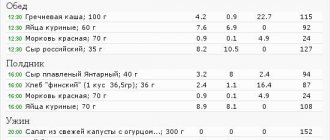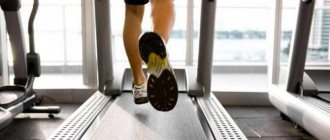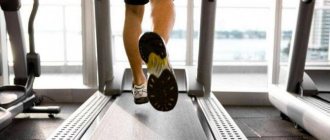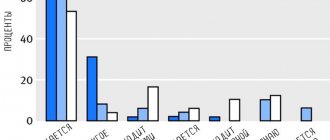Having decided to take care of yourself and your body, a person is faced with a choice - fitness centers and famous professional trainers offer dozens of different programs, starting with the classic full body, ending with tabata or special spiritual practices.
Moreover, each type of physical activity involves influencing certain muscle groups to achieve specific goals. Aerobic training is an effective “classic” that should definitely be included in the main training program. Provides a whole range of exercises performed to pleasant, rhythmic music. It is in great demand among those who plan to lose weight and are simply trying to lead a healthy lifestyle.
Myth #1: Crunches and/or sit-ups will help me lose weight around my waist.
You cannot lose weight locally - this means that you cannot reduce the percentage of fat in a specific place (unless we are talking about liposuction). If you eat less than you spend, persistently pump your abs and bend your body back and forth, this will lead to the fact that you will spend more energy, which means the percentage of fat will decrease throughout your body.
Yes, some people may notice that most of the fat is lost from the abdomen, but there is only one explanation for this: most likely, it is in this area that the largest fat reserves are concentrated. However, they can just as easily lose weight around the waist without exercising at all, or by cycling 90 minutes a day, or dancing tango three times a week, completely forgetting about sit-ups or crunches. It's about the calorie deficit, not the exercise.
Don't let those advertising "slim waist trainers" fool you. And don’t think that to successfully lose weight you have to train hard. Almost any physical activity (even non-sports activities, such as digging up a garden or rearranging furniture) burns calories. If you burn more calories than you consume, you will lose weight. That's why the best way for most people to maintain a healthy weight is to increase activity throughout their day, rather than doing a grueling 30-minute workout.
Strength and cardio training: combination options
Cardio before strength training
Many people believe that half an hour of work on a cardio machine will deplete glycogen stores, and during strength training the main source of energy will be fat. In practice, things don't look quite like this:
- The energy needed for effective strength training is wasted on cardio. The anaerobic part of the workout takes place without proper impact.
- Protein and only partially fat are used as an energy substrate.
The result: not fully developed muscles, increased wear on joints, significant loss of protein with minimal fat consumption.
Cardio after strength training
The power load is performed with maximum efficiency, glycogen is consumed as an energy source, again, provided proper nutrition. At the end of the cardio workout, there are remaining strength and glucose deficiency. The main energy substrate during aerobic exercise should be fat. What in practice:
- If after a strength workout you have enough energy to jog for half an hour, it means that you worked your muscles without full impact.
- Protein undergoes catabolic reactions faster and more easily than fat. Muscle tissue is consumed along with fat.
Bottom line: effective cardio training can follow strength training, provided that the strength training was light and you are not trying to preserve muscle volume as much as possible.
Strength and cardio training separately from each other
If you have the opportunity to train more than three times a week or twice a day, then it makes sense to separate aerobic and anaerobic training in time. When setting aside cardio training on a separate day, it is important to remember:
- Duration of at least 40 minutes. In the first half hour, the body uses up existing reserves of glucose and glycogen in the liver and muscles. Only then is fat included in metabolic processes.
- Pulse control. In order for the body to effectively burn fat and not switch to emergency energy supply reactions, heart rate (heart rate) should be at the level of 60-70% of the maximum. Max heart rate = 220 - age.
- The quality of breathing directly depends on the normal supply of oxygen to the body and the efficiency of fat burning. Breathing should not be shallow or intermittent. At any point in your workout, you should have no problem saying out loud, “Today is a great day and I had a good workout.” If stringing together a few words is a problem for you, reduce the intensity.
- Protein losses can be reduced through proper nutrition.
Morning jogging on an empty stomach also has its own characteristics:
- The body experiences a nutritional deficiency in the morning after an overnight fast. Fat is included in energy supply processes already at the beginning of work.
- Again, muscle tissue is consumed along with fat tissue due to the availability of protein as an energy source.
Bottom line: strength and cardio training should be separated for those who want to maintain muscle volume and get rid of excess fat. In this case, anabolic and catabolic processes will be separated in time, and the muscles will have time to recover after strength training. On aerobic days, fat burns with minimal loss of protein (don't forget about proper nutrition). Morning fasted cardio requires less time but uses more protein.
Strength and cardio two in one (interval training)
The workout is divided into microcycles of 6-10 minutes, during which aerobic exercise alternates with anaerobic exercise, heavy strength exercises with light multi-repetition exercises. For what? The bottom line is that energy supply processes in the body always take place in several possible ways, aerobic and anaerobic. Their ratio changes, but none of them is excluded. Interval training allows you to use all possible systems and processes in the shortest possible time. The effectiveness of fat burning increases significantly, since in addition to the immediate expenditure of calories, accelerated metabolism lasts almost as long as after strength training.
Important nuances of interval training:
- Not suitable for beginners due to high intensity.
- When exercising more than twice a week, the risk of developing overtraining and chronic fatigue syndrome increases.
Bottom line: interval training is suitable for those whose goal is to get rid of excess fat, provided they have a certain level of fitness and endurance.
Myth #2: You can’t combine aerobic and strength training on the same day.
Let's look at both situations: aerobic training before strength training and strength training before aerobic training.
1. Aerobic before strength training : Muscle cells need carbohydrates during strength training. Prolonged aerobic exercise (running, cycling, elliptical exercise, swimming, etc.) reduces glycogen stores (carbohydrates in stored form). The average glycogen reserve in the human body is approximately 500 g or 2000 kcal. Glycogen stores can be significantly reduced after vigorous aerobic exercise.
In practice, this means that if you do aerobic exercise first and then move on to strength training, your muscles may not have enough energy . This will cause your body to switch to breaking down protein (muscle, blood, lymph) to get the energy it needs. Yes, of course, fat reserves are your main “storehouse” of energy, but the breakdown of fat takes much longer.
2. Strength training before aerobic exercise: While studying at the University of Florida, I took part in a strength training study. Throughout the study, the authors carried out isometric measurements of leg muscle strength: the test subjects extended their knee on a special simulator at six different angles. And one day, after such extensions, I decided to take part in a tennis tournament. Or rather, I tried to participate. My thighs felt like wood! Or even lead. I could neither run, nor jump, nor change direction. I will never make such a mistake in my life. Of course, I lost the match.
Conclusion: it all depends on how intense the first workout was, their order is not important. Any high-intensity physical activity can significantly deplete your energy reserves, leaving you fatigued the next workout.
So, for the average person, doing both types of exercise on the same day can be considered normal. However, if your first training session was high intensity, wait a few hours before your second workout.
At least in theory, prolonged aerobic training before resistance exercise can lead to decreased performance. Therefore, if you are determined to combine two workouts in one day, then, for your own safety, do strength exercises first, and then move on to aerobic exercise. But here's my advice: Don't do any type of exercise right before an important tennis match, basketball game, or swimming meet!
What are aerobic workouts?
There are a huge number of aerobic programs performed at home, gyms or even outside. If you work out in a fitness center, you will be able to perform exercises on:
- Rowing machine.
- Treadmill.
- Exercise bike.
- Ellipsoid, etc.
Group classes include:
- Cycle.
- Fitball.
- Aerobics.
- Dancing.
You can do the same exercises at home. One gymnastic mat and simple sports equipment are enough.
Myth #3: Working out will turn your fat into muscle.
If you're just starting to exercise, you'll likely find that your muscle mass increases and your visible fat (subcutaneous fat) decreases. Therefore, there may be a mistaken impression that fat “transforms” into muscle. But in reality these are two completely different types of fabrics. It is as impossible as turning a liver into a heart or kidneys into lungs.
Research shows that fat cells don't actually disappear . Experts analyzed subcutaneous fat in long-distance runners: they compared runners who had always been in good shape with runners who had large fat reserves in the past. During the study, the percentage of subcutaneous fat in athletes from both groups was approximately the same.
However, when looking at the participants' subcutaneous fat cells under a microscope, the study authors found that the former fatties had a higher density of fat cells per gram of fat. In other words, their fat cells were simply smaller. Or, to paraphrase again, exercise does not cause your fat cells to melt like ice cubes on hot asphalt. It would be more correct to imagine this process as turning grapes into raisins.
Types of combining training and aerobics
♦ Without division:
In other words, this is strength aerobics, when everything is done at once, the load in this case is distributed 50 to 50 between classes with weights and aerobics, that is, by loading muscle areas, you do everything in a fast manner, using minimal rest time. As a result, the heart rate increases, metabolism accelerates, aerobics burns fat deposits, and constant muscle load minimizes their decrease in volume.
Advantages: time saving
Disadvantages: not suitable for beginners, training takes a lot of energy.
♦ Partial separation:
At first, you do a full strength training, and at the end of it, you do aerobics, if you do the opposite, you won’t have enough strength for the barbell and dumbbells, or rather, you can do it, but you will look like a sleepy fly











